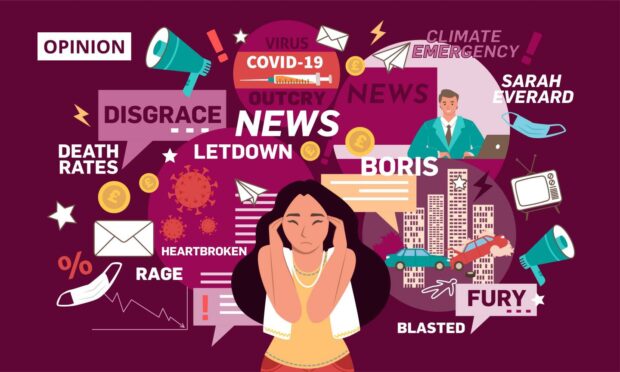I know, I know. I should be furious. We all should, this week.
I know I should be using my platform to join the army of dissenting voices tearing BoJo a new raw sewage line, and believe me, I want to.
But I can’t. Because honestly, I don’t feel angry – and that’s new for me.
See, I’m one of those unfortunates who cries when I’m angry, which is often.
It’s infuriating and completely undermines any attempt to be stern or intimidating. (Exes will testify to my growling ‘Don’t you dare comfort me’ through gritted teeth mid-argument.)
But irksome as it is, my rage-weeping is something I admire about myself. I like that I care so much, it spills over.
Usually.

Call it a mix of my Scottish blood and a general ‘nippy’ temperament, but I’ve never had a problem getting fired up about a cause, once I’ve dried my eyes.
Whether it was saving the rainforest by forcing Mrs McCallum to have a separate paper recycling bin in P3 (I was livid at the thought of Baghira and Baloo without a home) or writing to MP Chris Law to demand his support for the Black Lives Matter movement, my outrages have always propelled me to action.
The world’s on fire – why don’t I care?
Now, in 2022, it seems there are more reasons to be angry than ever.
The PM was partying while the nation watched their loved ones die on Zoom.
Domestic violence is going up.
Drug deaths are through the roof and people are freezing to death in their houses.
Sarah Everard was just walking home and no one is listening to Greta.
But I haven’t cried in months.
It’s not that I’m not angry – I’m sure I am.
But each day in the newsroom, I read the stories of political hypocrisy, the experiences of people from my town who are suffering, and I look for the fire in my belly and there’s nothing but heavy, cold coals in my gut.
I feel nothing.
Do you think I’m a monster? I do, sometimes.
But the good news is, if you find yourself relating to this, if apathy has greyed out your natural empathy, you’re not broken.
You’re just suffering the effects of our collective chronic outrage.
What is chronic outrage?
Here’s a wee biology lesson.
When you get angry, your body goes into fight-or-flight mode.
Your brain directs your blood away from your gut and into your muscles, and you get a big rush of stress hormones, like adrenaline and cortisol – the things that make you want to rush into action.
But if the body is continually put into a state of fight-or-flight without any respite, that energising adrenaline rush can turn into a state of chronic heightened anxiety, which causes emotional fatigue.
It becomes harder and harder to shock a perpetually-shocked nervous system.
And right now, a new reason for that fight-or-flight response arrives each time we open our phones.
Twitterverse is hotbed of chronic outrage
It’s easy, each time BoJo and Co open their snouts, or you see another climate crisis headline, to blast off an all-caps tweet and revel in the shared rage of all those wee pink hearts rolling in.
It can be validating, expressing that anger and getting it echoed right back, feeding the wee radge goblin inside with delicious morsels of righteous fury.
✅ 170k+ dead
✅ Highest Covid death toll in Europe
✅ Late to 3 lockdowns
✅ Bin bags for PPE
✅ Let Covid rip through care homes
✅ £37bn on failed Test & Trace
✅ Partied while people diedBut they “got the big calls right” https://t.co/IQgx6SMtdb
— David Schneider (@davidschneider) January 19, 2022
But then you look up from the phone after an hour of onanistic fuming, and your nails are chewed to nubs and you’ve stress-eaten half a pack of custard creams without tasting one and your tea’s cold.
And really, you’ve spent all that emotion and you’ve not changed anything.
So you feel powerless.
And that powerlessness breeds a resentment for the people who are suffering right there in public, on your screen.
In your weaker moments, that resentment towards the situation overrides your empathy for its victims.
You want to shout at it and then ignore it all.
And that’s how the baddies win.
Take the power back – anger is a weapon
From biology to physics – think of anger as potential energy, like a bar of uranium.
Stored and used correctly, it can be turned into power.
But if it explodes, or dissolves, it’s wasted.
Shouting your anger into the abyss of the Twitterverse is wasted potential energy – an often-pointless explosion.
Sometimes it says something new and important, but usually, all it does is add to a clamour which overwhelms everyone’s nervous systems until we all burn out.
If I was in power, and wanted a nation full of people too numb to challenge me, I’d quite like that.
So instead, why not harness your anger into your own power?
Take action; enact empathy.
Sign a petition, read a book, have a real life conversation with someone who thinks differently.
Make a change in your workplace, help out your neighbour, plant a garden for the bees – just do something.
Use your anger, if you still have it.
And if nothing else, cry about it.
Notice how powerful it feels to care.












